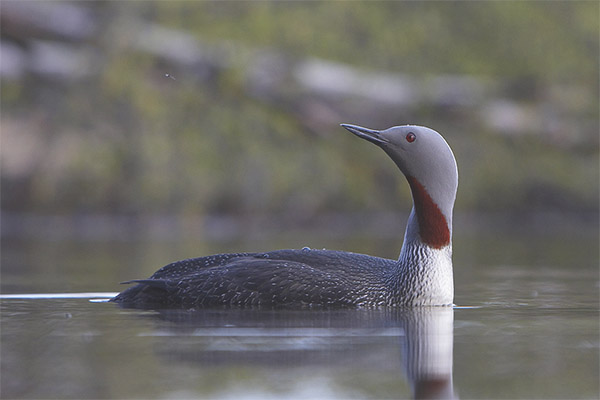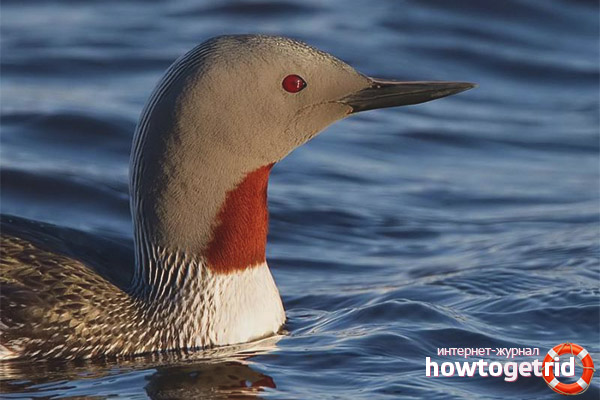The content of the article
Red-throated Diver is a bird from the genus Hagar, which can boast of its ancient history. The ancestors of this amazingly beautiful bird flew over the earth more than 30 million years ago. Red-throated loon - the smallest of the representatives of its kind, weighs only 1.5-2 kg. This is an elegant bird with a long beak, for which it is very interesting to watch.
The appearance of the red-breasted loon
The length of the body of the feathered representative is 50-70 cm, the wingspan is just over a meter. The upper body and wings appear monotonously gray, but when approaching, you can see small white spots, concentrated on the neck. The abdomen of the bird is light, almost white. The characteristic feature of the bird is a reddish and reddish speck on the front side of the neck. Despite the rather bright color, the spot is noticeable only at close range, it cannot serve as a defining feature. The bird's beak is rather thin, slightly bent top.In addition, the loon has a habit of keeping it slightly upturned, which is why many people call the bird a “snub”. By the color of the beak, you can determine the age of an individual - in young it has a gray tinge with a black border, in mature loons the beak is completely black. The legs of loons are also black, with subtle pink membranes.
Habitat
Features of the bird's lifestyle
Today, the loon is considered an endangered species and is strongly protected by environmental organizations.The cause of the problem is the widespread pollution of the natural habitat. In the dirty water, the loon is harder to find food for itself, the birds are dying from heavy metal poisoning. Until recently, the birds were actively exterminated by fishermen, moreover, the loons were confused in the established fishing nets. Today, the red-breasted loon population is being restored in every way, and even artificial mounds and islets are being built on the large lakes of North America to attract the bird population.
Red-throated loon feels great in the water, moves well, dives perfectly and swims. In the event of a danger, a loon can be completely submerged in water, leaving only the head and a narrow strip of the neck on the surface. The ability to control the body is simply amazing - a loon can float on its side, often stands on the surface of the water, flapping its wings, and in some cases it is able to float even upside down - up belly. A loon is able to hold the air for a full minute, as well as dive 10 meters into the depth of the water column. In flight, the loon resembles a duck, although it has larger and pulled back paws.In the air, a red-sided loon is a loner who does not even allow her partner to get too close. On land, the loon walks quite rarely, moving up the belly and breast, pushing the body with its paws. The bird flies much more willingly than its close relatives, with the danger of a red-sided loon it will rather rise into the air than dive into the water. An amazing feature of a bird is its ability to rise into the air with almost no run up. That is why the loon nests with pleasure on small lakes, and flies to fly to large nearby reservoirs. Divers can live singly, in pairs and in small flocks of 6-8 individuals. In the period of cold weather and migration for wintering, the loon can form fairly large flocks of up to 500 individuals.
Loon can get its food both day and night, equally well being guided in the water space. The main feed is any small fish. A small fish loon swallows right under the water, and a large fish makes to the surface and kills with its powerful beak. In addition to fish, the red-breasted loon can eat caviar, frogs and crustaceans. In early spring, when the lakes are still under the ice, the bird eats the first vegetation with pleasure.
Interesting Facts
Red-throated Diver is not just beautiful, but also an amazing bird, for which it is interesting to watch.
- During the flight, the loon is able to reach speeds of 50-60 km per hour.
- When red-wounded loons fly for the winter, they do not interrupt the flight, not only during the day, but at night.
- Red-throated Diver is able to make a special sound that is very similar to a cat's meow. So the bird scares a stranger or drives him away from the nesting site.
- Red-throated loons are monogamous and form a pair for life.
- For one immersion loon is able to swim up to one hundred meters. Her blood is perfectly saturated with oxygen, so the bird is able to hold its breath for a long time. And large and heavy bones make an excellent diver from the divers, who can easily sink to the very bottom after the prey.
- Eggs are incubated not only by the female, but also by the male, closely guarding the surrounding territory. When a person approaches, the female descends into the water, distracting the enemy from the nest, the bird at this moment is able to let the person as close as possible, if only he does not approach the clutch.
It is very interesting to watch the bird that lubricates the feathers. In the process of this loon can take the most unusual and amazing posture, sometimes lying in the water supine, smoothing the feathers on the abdomen with the help of the beak.
Red-throated Diver is an excellent type of loon, which amazes not only with its exquisite appearance, but also with its physical skills.
Video: Red-throated Loon (Gavia stellata)












To send